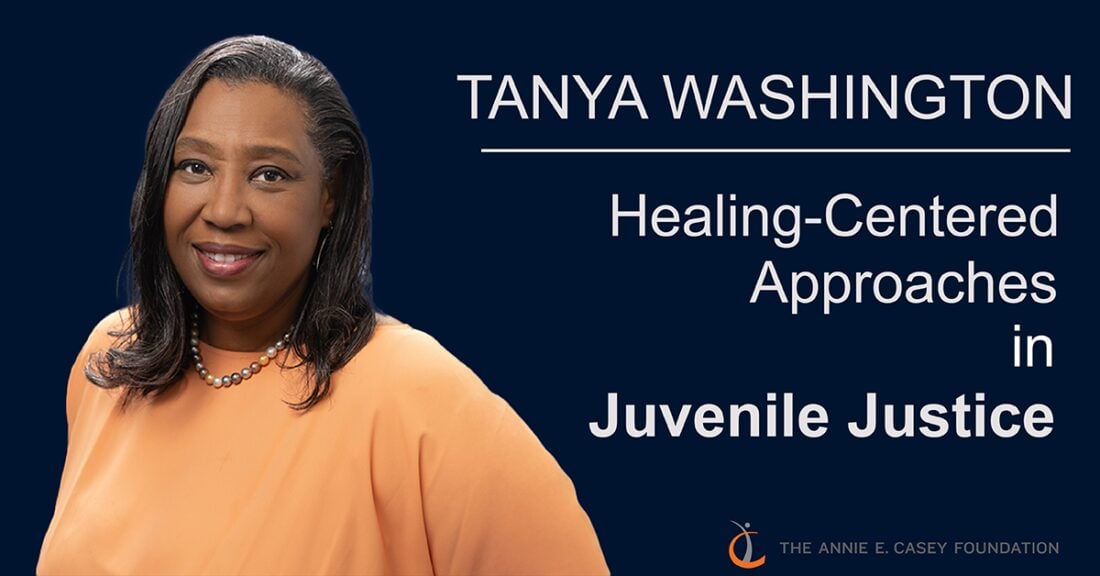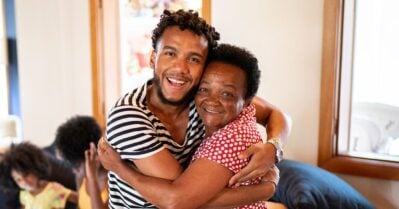Healing-Centered Approaches in Juvenile Justice
A Q&A With Tanya Washington

In this Q&A, Annie E. Casey Foundation Senior Associate Tanya Washington explores the role of healing in fostering safer communities and helping young people with justice-system involvement thrive.
Q: Discussions about healing should begin with recognizing the trauma these young people have experienced, right?
Washington: Yes. Trauma and severe poverty are common in young people who commit offenses. Traumatic childhood experiences, such as hunger and witnessing or being victimized by violence within the family or community, profoundly affect adolescent brain development. Over half of justice-involved youth have experienced such trauma.
Research makes clear that young people who are involved in the juvenile justice system are far more likely than other youth to have suffered trauma in their lives. With these statistics in mind, individuals working in the juvenile justice field should understand that trauma can lead young people to have a hard time trusting people; feel hurt, rage and sadness; take the hurt out on themselves and others; and not be able to imagine their future, let alone plan for it.
Q: What do you want juvenile justice practitioners to know about trauma?
Washington: Trauma-induced behaviors by young people and family members can be misidentified as acting out, noncompliance, resistance or apathy. Caseworkers may react to the behavior without recognizing, exploring or responding to the factors behind it. One of those factors is science. While I’m not a doctor, I have learned that childhood trauma is known to affect brain development, including enlarging the amygdala. This can manifest in exaggerated emotional reactions, such as a fight or flight response.
When young people are acting out due to trauma, pain and unmet needs, their behaviors will not improve through surveillance and incarceration; these responses only exacerbate the trauma and the behavior. And for youth who enter the justice system without prior trauma, a focus on surveillance and incarceration can introduce trauma for the first time.
As much as we would like young people to be “healed” and be done with it, the healing process is often marked by ups and downs, progress and setbacks. Young people are likely to need ongoing support and compassion.
Q: Does childhood trauma damage young people forever?
Washington: Childhood trauma is known to impact brain development and can have long-term effects. Even so, it does not have to shape a young person’s destiny. Young people have the capacity to grow, learn and flourish with the right support and opportunities. This includes being able to focus on the future and set forward-looking goals.
Q: What is a healing-centered approach?
Washington: Healing is a process through which young people acknowledge their trauma and connect with individuals and resources that support them in confronting and reframing painful experiences. It’s young people having the opportunity to address whatever harm they caused others and heal from harm inflicted on them.
People may have heard of a trauma-informed approach, which emphasizes how trauma shapes an individual’s behavior and employs practices that avoid triggers that reactivate the individual’s flight-or-fight reaction. Shawn Ginright, a professor and author, describes his vision for a healing-centered approach as “not simply an individual isolated experience, but rather the ways in which trauma and healing are experienced collectively.” His example: Researchers have shown that children in neighborhoods with high levels of violence all display behavioral and psychological elements of trauma. For him — and for me — healing-centered engagement views trauma and well-being as functions of the environments where people live, work and play. The goal is enhancing the conditions that contribute to well-being. “By only treating the individual, we only address part of the equation leaving the toxic systems, policies and practices neatly intact,” Ginwright writes.
Q: How is a healing-centered approach different from traditional approaches in juvenile justice?
Washington: Healing-centered approaches give young people the tools to recognize their behavioral triggers and cope with their emotions. The tools are individualized and consider what the given young person needs to feel safe — emotionally and physically — and connected to positive people they trust. These are some of the precursors for young people to mature into healthy adults. They are what make youth receptive to personal growth and more responsible decision making.
Healing is a proactive, rather than punitive, public safety strategy. Traditional juvenile justice approaches often focus on control and punishment. The youth prison model assumes that incarcerating young people is necessary for public safety and that punishment deters crime. However, this strategy fails to address the reasons young people break the law. Many young people make poor choices due to a lack of hope, but public systems often respond to the behavior itself rather than the underlying causes, further deepening the trauma that led to the behavior.
Q: What are some effective strategies to support healing?
Washington: Healing circles, a group therapeutic approach developed to help military veterans reduce aggression, increase hope and build interpersonal connections, has been adapted to youth in correctional facilities and in their communities. Trained facilitators help participants process painful memories, develop coping skills and rebuild trust with families and communities. Participants agree to confidentiality and mutual respect, creating safe spaces for honest expression. The steady, consistent contact with caring adults leads to the kind of enduring relationships that all young people need to feel safe and supported. In New Jersey, among the participants in a healing circle initiative, there was a 45% drop in disciplinary infractions, and youth reported improved emotional regulation and communication. These outcomes demonstrate that empathy and trust can lead to significant change.
Young adulthood, which lasts well into our 20s, is critical for building the social and emotional skills adults need to succeed. Getting the right help during this important period of growth can make all the difference for a young person trying to move in a positive direction. Even young people with violent pasts and childhood trauma can become successful adults if we allow them opportunities to re-script their negative experiences and make amends for the harm they have caused.
There’s also a place for activities that spark joy and a sense of purpose. Celebrating small victories is part of normalizing hopefulness.
Q: What is the role of credible messengers in the healing process?
Washington: Credible messengers are individuals with experience in the justice system (or similar tough environments) who can build trust with youth through empathy and shared understanding. These messengers are often from the same communities and have similar life experiences as justice-involved youth, and they can provide guidance and serve as role models. Building those trusting relationships before a young person returns home from incarceration, or even before they are incarcerated, can help keep young people on the right track.
Systemic barriers, however, can make it difficult for young people to receive this kind of support. For example, some states restrict individuals with felony records from working with youth with justice involvement. To better reach young people, systems should meaningfully partner with people who have relatable experiences to the young people and can interact with them without judgment.
Individuals who are closest to the experience are often closest to the solutions. Credible messengers can show young people examples of what a successful, law-abiding life looks like and what’s possible for their futures.
When credible messengers themselves have healed to the point where they are no longer living in survival mode, they can be open and vulnerable with their mentees. A powerful, trusting bond can form, which creates a safe space for young people to practice managing and coping with the feelings and sensations that come in the aftermath of trauma. It encourages their resilience and transformation.
Learn how New Jersey uses healing circles to support youth coping with trauma





